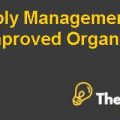
Introduction
The paper attempts to describe the main concept of E-procurement in supply chain management along with its execution and the available technologies. The paper also attempts to provide the different e-procurement systems and their best practices. Furthermore, the paper aims to discuss the research and new trends for e-procurement. Lastly, the paper discusses the supply chain coordination in HYDRA, an e-procurement system and its monitoring.
The Basic Concepts in E-procurement for Supply Chain Management
The current world economic system is facing increase in competitiveness and needs to sustain in the competitive environment in order to achieve profitability. However, many firms would choose to increase their prices to sustain in the environment, while the wisest of the firms would focus on increasing innovation, maintain higher quality, and to increase the response time to manage their cost effectively. Therefore, achieving these efficiencies at the lowest possible cost spent in the business model would help an organization to earn a competitive edge in the market. While adhering to these factors, these competitive dimensions can only be managed efficiently through effective supply change management. The process of supply chain management involves all the activities that are associated with the transformation and the flow of goods where the product is received by the end user since its inception as a raw material. The process also involves the flow of information through the organization and integrating the different business processes of a company and transforming into a sustainable competitive advantage.
Since the introduction of the new era of modern technology, the supply chain management has also evolved and transformed itself in to a broader field. Supply chain management has spread its wings in value and industrial engineering, electronic procurement, and supplier development. However, these terms may not be new in the supply chain management, but it is now being rediscovered in the modern era. Although, electronic procurement which increases the efficiency of the supply end through the use of internet, it could be considered as a new approach to improve competitiveness. Since the emerging of e-procurement in the supply chain management, a higher profile and visibility has been maintained for the top management (Broggi, 2009).
E-procurement process is the integration of business processes and systems, the purchase order management and the accounting process through the productive use of the internet. E-procurement is the process where the information and flow of goods are carried out through the use of internet which has made the process of supply chain cost effective and has aided in achieving sustainable advantages. As provided in Figure 1, the e-procurement process includes the initial step of buyer maintaining a requisition request. The bidding is placed in the second step after which supplier is selected for contract preparation. Furthermore, the order process from supplier gets started in the sixth step, whereas, the seventh step focuses on the delivery of the shipment. Lastly, the payment to supplier is made. These are the main concepts and steps included in the e-procurement (United Nations, 2006).
Structures of Supply Chain Management
Broggi (2009) argues that the most preferable organizational structure in maintaining quality management is the centralized decision making structure that has a level of formalization. The process of formalization could be defined where the rules and procedures which are authorized in a company are allocated through formal rules and policies (Broggi, 2009). The particular process is low in flexibility which identifies that a lower flexibility results in high level of formalization. The idea of centralization in the supply chain management process has been essential because each department has to manage and has the responsibility for its own tasks and targets. The concept refers to the roles and tasks assigned on the basis of individuals’ capacity and attributes. In a simpler terms, the entire procedure is standardized (Heywood & Barton, 2002). However, if the strategy of the company is based on achieving cost benefits, then it is more likely that the company would implement a formal structure where each individual would be assigned to perform a particular task. However, if the company aims to achieve product innovation, then the level of centralization would be low as the new product ideas are more likely to be gained from the lower and the middle management level...................
This is just a sample partial case solution. Please place the order on the website to order your own originally done case solution.













